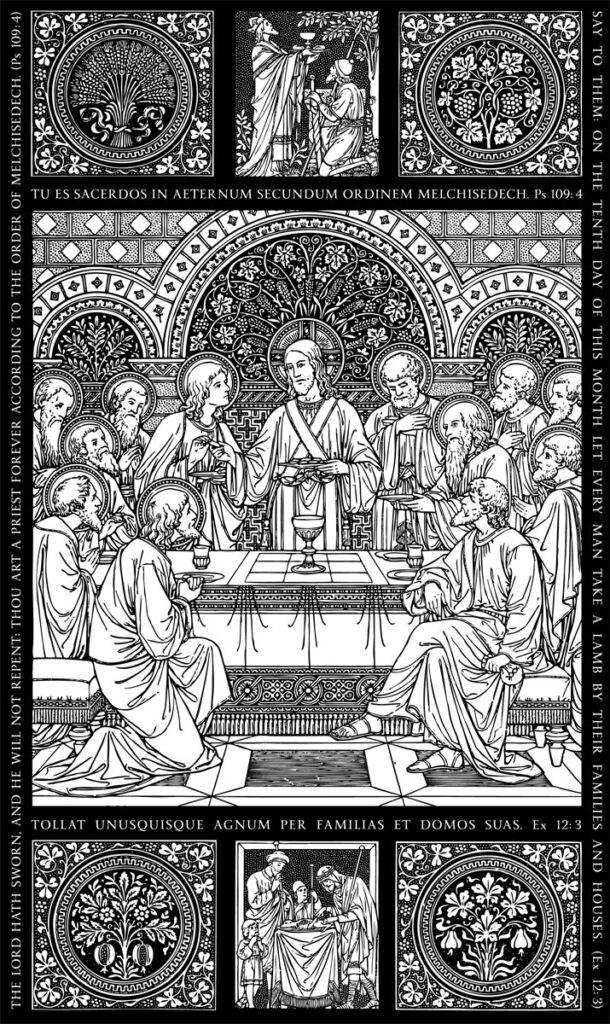Home l Liturgy & Sacraments l Liturgical Calendar
Maundy Thursday

The Liturgy of Maundy (Holy) Thursday is full of memories of the Redemption. It provided formerly for the celebration of three Masses: the first for the reconciliation of public penitents, the second for the consecration of the holy oils, and the third for a special commemoration of the institution of the Holy Eucharist at the Last Supper. This last Mass is the only one that has been preserved, and at it the bishop, attended by twelve priests, seven deacons, and seven subdeacons, blesses the holy oils in his Cathedral church.
The Reconciliation of Public Penitents
The Church, endowed with the power of laying down the conditions necessary for the validity of the Sacrament of Penance, required in the fist centuries, that after open confession of sins of public notoriety, described by the Fathers of the Church as capital sins, the absolution should be preceded by the complete fulfilling of the satisfaction or penance. Hence the rite of the reconciliation of penitents, who on Maundy Thursday received the sacramental absolution of the sins for which they had done public penance during Lent. To this may be traced the Easter Confession following the forty days’ penance. In the beginning of the fourth century private penance came more largely into vogue, and this led gradually to the reversal of the practice aforesaid now in general use, the absolution being given immediately after the confession, and being followed by the performance of the penance imposed.
The Blessing of the Holy Oils
This blessing took place with a view to the baptism and confirmation of the Catechumens during Easter night.
The oil of the sick, which is the matter of the Sacrament of Extreme Unction, is blessed before the Pater.
The Holy Chrism which is the matter of the Sacrament of Confirmation, is the noblest of the holy oils, and the blessing of it takes place with greater pomp after the clergy have communicated. It is also used for the consecration of churches, altars and chalices, and in the baptism or blessing of bells.
The third holy oil, which is blessed immediately after, is that of the catechumens. It is used in the rite of baptism, at the ordination of priests, for the coronation of kings and queens, and with the Holy Chrism for the blessing of the font and consecration of altars.
Mass for Maundy Thursday
The Church today lays special stress on the institution of the Holy Eucharist and of the priesthood. This Mass carries out more than any other the command of Christ to His priests to renew the Last Supper, during which He instituted His immortal presence among us at the very moment His death was being plotted. The Church, setting aside her mourning today, celebrates the Holy Sacrifice with joy. The crucifix is covered with a white veil, her ministers are vested in white, and the bells are rung at the Gloria in excelsis.
After the Mass the altar is stripped in order to show that the Holy Sacrifice is interrupted and will not be offered up again to God until Holy Saturday. The priest therefore consecrates two hosts, for on Good Friday the Church refrains from renewing on the altar the sacrifice of Calvary.
Indulgences for Maundy Thursday
Pius VII granted a plenary indulgence to all who on Maundy Thursday perform some pious exercise (reading, meditation, or office) for one hour in commemoration of the institution of the Holy Eucharist, provided that, being truly contrite, they go to confession and Holy Communion on that day or on any day of the week following.
He also granted a plenary indulgence to all who pay a visit to the Blessed Sacrament at altars of repose on Maundy Thursday and Good Friday, and pray there for the intention of the Sovereign Pontiff, provided they have been to confession and that they go to Holy Communion on Maundy Thursday or on Easter Sunday.
Copyright © 2015-2024 Saint Joseph Catholic Church, Latin Mass Parish, 602 S 34th St., Tacoma, WA 98418. All Rights Reserved.
Website comments or questions: info@saintjosephtacoma.org


